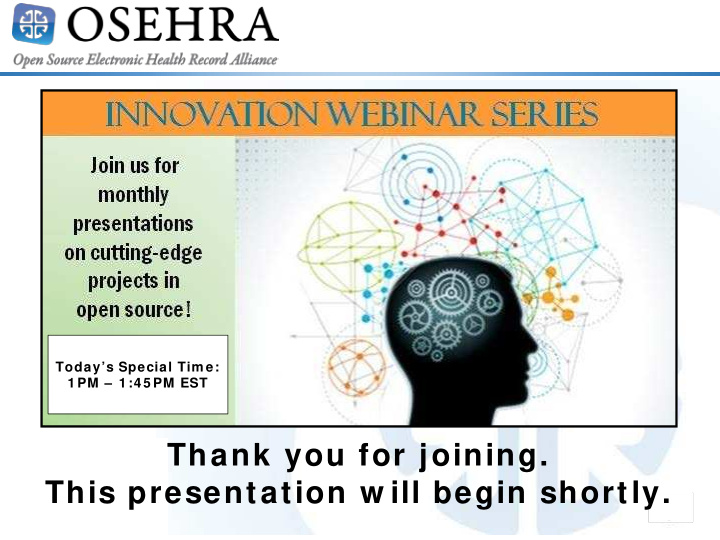



Today’s Special Tim e: 1 PM – 1 :4 5 PM EST Thank you for joining. This presentation w ill begin shortly.
I ntroduction by Seong K. Mun, PhD • Goal of this webinar is to share some information and assist in responding to the RFI • This session will end at 1:45 PM sharp • The session will be recorded • Some IHS executives may join the call • Questions can be submitted via the WebEx chat feature 2
Welcome to the OSEHRA Innovation Webinar I HS RFI on RPMS Discussion Sam Habiel, Pharm .D. Theresa Cullen, MD, MS Associate Director Technical Fellow OSEHRA Global Health I nformatics Program Regenstrief I nstitute, I nc.
Outline 1. Why Now? 2. Clinical IT situation 3. What is RPMS and how is it unique? 4. History of RPMS 5. Viability of RPMS without VistA 6. RPMS and the Open Source Community 7. OSEHRA Resources for RPMS
W hy Now ? • VA Cerner decision • Indian Health Service needs a solution that is affordable, maintainable, and meets the unique needs of providing comprehensive care in the most remote areas of the US • Financial constraints are significant compared to the VHA and DoD • Support needed for RPMS after ARRA Incentives discontinued • Opportunity to jumpstart a new way to provide HIT support
Clinical I T situation • Primary care – High vacancy rates; many ‘moonlighters’ • Few specialists • Most hospitals are small, rural, with limited resources – Though there are medical centers and they need to be supported also • Team based care with historical and ongoing commitments to care improvement (e.g. IHI initiative) • Tracking measures that are principally primary care based (as opposed to SAIL at the VHA) • Local IT staff is mostly locally hired
W hat is RPMS? • A VistA sibling, not child – Shares the same infrastructure – Different Clinical Applications • An EHR that is strongly focused on primary and team based care, prevention and health maintenance, and attention to social determinants of health • Committed to support a longitudinal health record and Population Health • Needs to meet federal GPRA reporting requirements, as well as, sending data to the National Data Warehouse • ARRA Stage II Certified
History of RPMS • IHS started retaining medical records in 1969 • RADEN PCIS RPMS • Early success stories with PCIS included the stopping of the death of infants from gastroenteritis
History of RPMS ( cont) • Lessons from PCIS and RADEN • + Strong population focus with statistical research • - reliance on mainframe and non-DBMS technology made PCIS too expensive; constant target of cutbacks • - RADEN was difficult to move from its aging platform
History of RPMS ( cont) • Founding Ideas for RPMS – Decentralized to the point of patient care – Vendor-independent and portable across hardwares – More local control over data systems – Responsive to community and population health needs
History of RPMS ( cont) • RPMS Development – Stuck to vendor independent platform (Plessy rather than PDP-11; MSM rather than DSM) – Written and deployed by the clinicians using the system; sometimes the same people doing both jobs (esp Dr. Greg Shorr) – Strong push to use RPMS with patient care; rather than “after the fact” record system. – The strongest RPMS developers were women
History of RPMS ( cont) • More on RPMS history can be found on https://www.osehra.org/content/rpms
RPMS Technical Stack • Intersystems Caché on – MS Windows Servers (majority) – IBM AIX Servers • Majority of server code is standard M95 – Recent exceptions in a handful of packages written in COS • Clients – Windows Applications written in Delphi, C#, and some VB6
Viability of RPMS w / o VistA • RPMS uses the same infrastructure as VistA, almost completely unmodified. • RPMS uses many clinical applications from VistA, modifications range from slight (Radiology), to heavy (Pharmacy, TIU), to heaviest (Lab). • BCMA, VistA Imaging, the Lexicon, ICD/CPT code sets, and the National Drug File are identical. • More info: http://smh101.com/articles/rpms_vista_convergen ce.html
Viability ( cont) • IHS has always maintained the clinical applications fine on their own with successful delivery of useful software • But beholden to VA for – Infrastructure Code – Terminologies – Unmodified Applications (e.g. VistA Imaging)
Viability ( cont) • Independent of VistA and VA, RPMS is difficult to configure and support. – Requires a lot of expertise • ARRA legislation burdened IHS with developing and maintaining inconsequential improvements to RPMS (MU II certified now) • Lack of funding makes keeping-up difficult • Let’s address Politico’s comment of “antiquated system”
RPMS in Open Source • The open source community has always focused on systems that can run hospitals rather than clinics – Choose OpenMRS/OpenEMR instead • Places that implemented RPMS that match IHS in needs (Guam, Samoa, Hawaii, West Virginia) • Some had to leave it due to lack of support
RPMS in Open Source • Use of proprietary technologies in the last few years made RPMS open source unfriendly – COS – Use of Ensemble – Use of Silverlight • RPMS can be a viable open source EMR, but it needs work to get there
OSEHRA Resources • ViViaN-R, for exploring RPMS – http://code.osehra.org/vivianr/ • Docker image, for running all of FOIA- RPMS – https://hub.docker.com/r/osehra/rpms/
Questions?
Thank You for Attending! Please Join our next W ebinar: February 2 0 , 2 0 1 8 3 :0 0 PM EST Blockchain for Health Data and Its Potential Use in Health IT and Health Care Related Research Presented By: Laure Linn CTO, HyperLinkMed.com
Recommend
More recommend